Regardless of how midterm elections turn out, Wall Street usually ends up a big winner.
The S&P 500, the stock market's benchmark index, has climbed in the 12 months after each of the midterm elections going back to 1946. That's 18 elections, many of which ended up shuffling the balance of power in Congress.
Click to Gallery
Regardless of how midterm elections turn out, Wall Street usually ends up a big winner.
In midterms going back to 1946, the S&P 500 index had an average price return of 16.7 percent in the 12 months after the elections, according to CFRA.
True, they're not bad. They're just not as good as in the other scenarios.
The length of the current bull market, now at more than nine years — the longest ever — also has some investors worried that stocks are overdue for a severe pullback.
So, investors must prepare for anything. The outcome of the elections may have policy implications that could affect some sectors of the market, including banking, companies that would benefit from government infrastructure projects and those that rely on healthy consumer spending, analysts say. It just depends on which party is in control.
In the scenario where Democrats regain control of the House, major policy initiatives from the White House will be dead on arrival. Democrats might find common ground with the GOP on an infrastructure bill or on legislation to control drug pricing.
"It turns out that under every political makeup in Washington, stocks have gone up and the economy has grown," said Kate Warne, an investment strategist for Edward Jones.
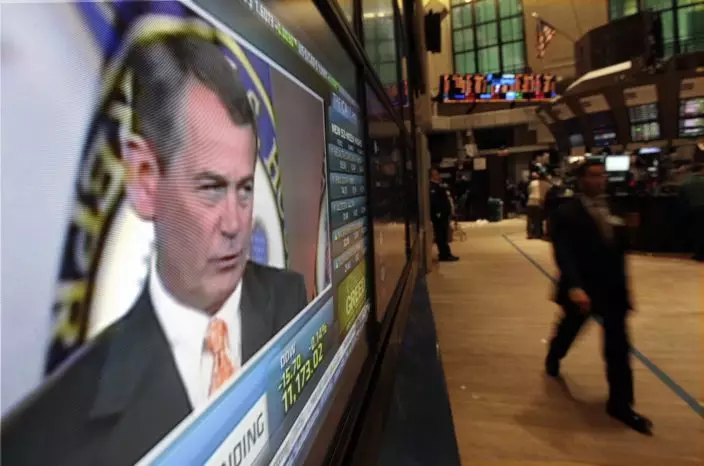
FILE- This Nov. 3, 2010, file photo shows U.S. Rep. John Boehner, R-Ohio, on a television screen on the floor of the New York Stock Exchange a day after the midterm elections. The S&P 500, the stock market’s benchmark index, has climbed in the 12 months after each of the midterm elections going back to 1946. That’s 18 elections, many of which ended up shuffling the balance of power in Congress. (AP PhotoRichard Drew, File)
In midterms going back to 1946, the S&P 500 index had an average price return of 16.7 percent in the 12 months after the elections, according to CFRA.
Right now, polls show Democrats taking control of the House in the Nov. 6 elections while Republicans retain control of the Senate. One popular adage is that Wall Street likes gridlock in Washington, because it creates less uncertainty and diminishes the likelihood of major legislation that could upset the markets.
"There are big issues that need to be resolved and gridlock means those get deferred or pushed forward," Warne said. "That's disappointing but doesn't necessarily mean market returns are bad."
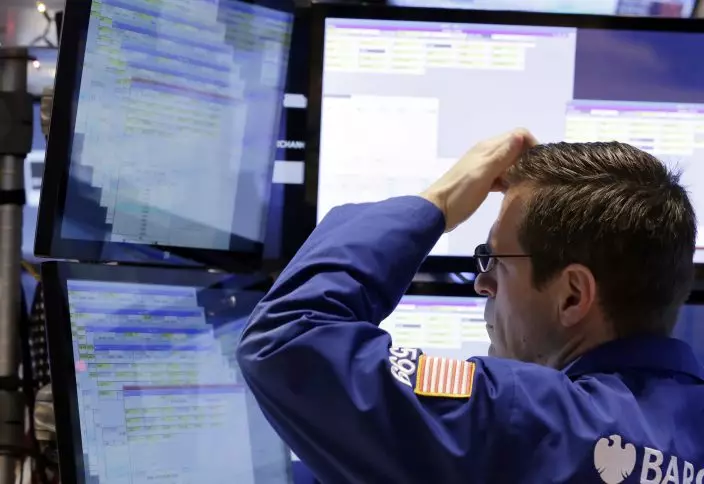
FILE- In this Dec. 5, 2014, file photo specialist Charles Solomon works at his post on the floor of the New York Stock Exchange. The S&P 500, the stock market’s benchmark index, has climbed in the 12 months after each of the midterm elections going back to 1946. That’s 18 elections, many of which ended up shuffling the balance of power in Congress. (AP PhotoRichard Drew, File)
True, they're not bad. They're just not as good as in the other scenarios.
"The best scenario (for the market) is when one party controls all branches of government," said Sam Stovall, chief investment strategist for CFRA. "The second best is a unified Congress. The worst is a divided Congress."
Recently, markets have had other worries beside the elections. After a solid third quarter that saw records for the S&P 500 and Dow Jones industrials, stocks have swooned on fears that rising interest rates and the U.S. trade dispute with China could undo some of the benefits of the GOP tax cuts and eventually squeeze corporate profit margins.
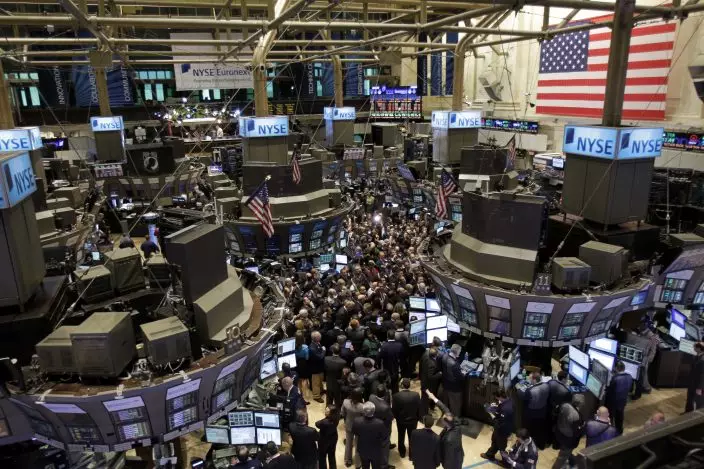
FILE- In this Nov. 18, 2010, file photo traders gather near the post where General Motors Co. stock trades at the New York Stock Exchange. The S&P 500, the stock market’s benchmark index, has climbed in the 12 months after each of the midterm elections going back to 1946. That’s 18 elections, many of which ended up shuffling the balance of power in Congress. (AP PhotoSeth Wenig, File)
The length of the current bull market, now at more than nine years — the longest ever — also has some investors worried that stocks are overdue for a severe pullback.
Currently, the U.S. economy is growing at the best clip in years. The earliest most experts see a recession in the U.S. is 2020. And Wall Street continues to expect solid growth from companies reporting third-quarter results the next few weeks.
History shows that voters have been more likely to support incumbents when the economy is strong, which could be good news for the GOP. But history also shows the president's party typically suffers big losses in the first midterm elections after taking office. In recent history, the party holding on to the White House lost the majority in one or both houses of Congress in every midterm going back to 2002.

FILE- In this Sept. 6, 1947, file photo a small flurry of activity can be seen in the upper right where several members are ascertaining the market for one of the issues traded at that post and in the lower right one of the Curb reporters who dispatch information on buy and sell orders to the Central Ticker Desk for transmission on the Curb Ticker in New York works. The S&P 500, the stock market’s benchmark index, has climbed in the 12 months after each of the midterm elections going back to 1946. That’s 18 elections, many of which ended up shuffling the balance of power in Congress. (AP PhotoDan Grossi, File)
So, investors must prepare for anything. The outcome of the elections may have policy implications that could affect some sectors of the market, including banking, companies that would benefit from government infrastructure projects and those that rely on healthy consumer spending, analysts say. It just depends on which party is in control.
Should Republicans remain in control of Congress, it's likely the Trump administration will try to make the personal tax cuts included in last year's reform package permanent. Also, on the possible to-do list: reforming entitlements, more easing of government regulations on banks and other businesses and perhaps tackling the issue of drug price controls, according to a report from UBS on the potential impact of the midterm elections.
If the GOP extends its majority, there could be a push to lower capital gains taxes and enact an infrastructure spending bill.
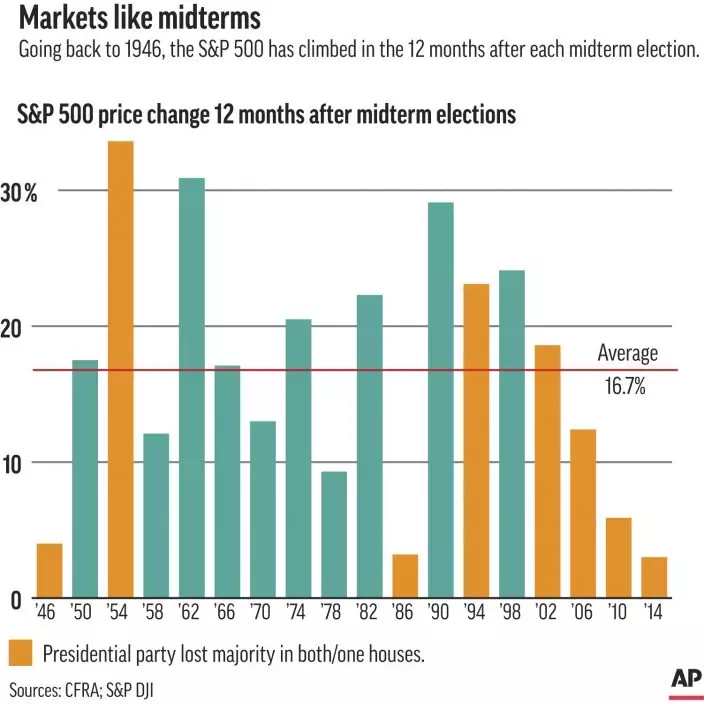
This Thursday, Oct. 18, 2018, image shows an Associated Press graphic. The S&P 500, the stock market’s benchmark index, has climbed in the 12 months after each of the midterm elections going back to 1946. That’s 18 elections, many of which ended up shuffling the balance of power in Congress. (AP Graphic)
In the scenario where Democrats regain control of the House, major policy initiatives from the White House will be dead on arrival. Democrats might find common ground with the GOP on an infrastructure bill or on legislation to control drug pricing.
But generally analysts expect gridlock to seize Congress. Compromise could be difficult, especially if the Democrats move to impeach Trump.
If Democrats get control of the House, Senate or both, analysts expect to see more investigations of big banks and Wall Street firms.
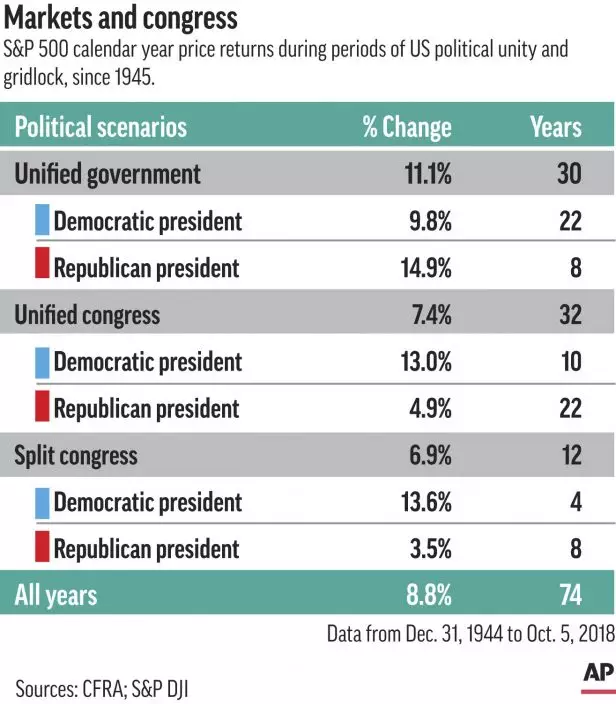
This Thursday, Oct. 18, 2018, image shows an Associated Press graphic. The S&P 500, the stock market’s benchmark index, has climbed in the 12 months after each of the midterm elections going back to 1946. That’s 18 elections, many of which ended up shuffling the balance of power in Congress. (AP Graphic)
"Headline risk for the banking industry would significantly increase as we anticipate numerous congressional hearings to investigate Wells Fargo and other large banks," analysts at Keefe, Bruyette & Woods wrote in a recent election analysis.
San Francisco-based Wells Fargo has faced several investigations in recent years over practices including the opening of accounts without customers' consent, charging clients for unnecessary insurance policies, and imposing unfair fees tied to mortgage rates.
UBS also sees the possibility of a government shutdown increasing with a divided Congress, noting that during the government shutdown that occurred during Congress' 2011 debt ceiling impasse the S&P 500 slumped nearly 20 percent.
However, it's unlikely that even if Democrats win control of Congress they will be able to reverse the Trump tax cut and the White House's rollback of government regulations on businesses.
"With this in mind, this election is really about how dysfunctional Washington will be for the second half of President Trump's first term," Mike Ryan, chief investment officer, Americas, for UBS Global Wealth Management, noted in the report.
VENICE, Italy (AP) — Under the gaze of the world’s media, the fragile lagoon city of Venice launches a pilot program Thursday to charge day-trippers a 5-euro (around $5.35) entry fee that authorities hope will discourage visitors from arriving on peak days and make the city more livable for its dwindling residents.
Signs advising arriving visitors of the new requirement for a test phase of 29 days through July have been erected outside the main train station and other points of arrival.
Some 200 stewards have been trained to politely walk anyone unaware of the fee through the process of downloading a QR code. A kiosk has been set up for those not equipped with a smartphone. Once past designated entry ports, officials will carry out random checks for QR codes that show the day-tripper tax has been paid or that the bearer is exempt.
Transgressors face fines 50 euros to 300 euros. The requirement applies only for people arriving between 8:30 a.m. and 4 p.m. Outside of those hours, access is free.
“We need to find a new balance between the tourists and residents,’’ said the city’s top tourism official, Simone Venturini. “We need to safeguard the spaces of the residents, of course, and we need to discourage the arrival of day-trippers on some particular days.”
Venice has long suffered under the pressure of over-tourism, but officials say that pre-pandemic estimates ranging from 25 million to 30 million visitors a year — including day-trippers — are not reliable and that the pilot project also aims to come up with more exact figures to help better manage the phenomenon.
By contrast, registered visitors spending the night last year numbered 4.6 million, according to city figures, down 16% from pre-pandemic highs.
Venturini said the city is strained when the number of day-trippers reaches 30,000 to 40,000. Its narrow alleyways are clogged with people and water taxis packed, making it difficult for residents to go about their business.
Not all residents, however, are persuaded of the efficacy of the new system in dissuading mass tourism, and say more attention needs to be paid to boosting the resident population and services they need.
Venice last year passed a telling milestone when the number of tourist beds exceeded for the first time the number of official residents, which is now below 50,000 in the historic center with its picturesque canals.
“Putting a ticket to enter a city will not decrease not even by one single unit the number of visitors that are coming,’’ said Tommaso Cacciari, an activist who organized a protest Thursday against the measure.
“You pay a ticket to take the metro, to go to a museum, an amusement park; you don’t pay a ticket to enter a city. This is the last symbolic step of a project of an idea of this municipal administration to kick residents out of Venice,” he said.
Venturini said about 6,000 people had already paid to download the QR code, and officials expect paid day-tripper arrivals Thursday to reach some 10,000.
More than 70,000 others have downloaded a QR code denoting an exemption, including to work in Venice or as a resident of the Veneto region. People staying in hotels in Venice, including in mainland districts like Marghera or Mestre, should also get a QR code attesting to their stay, which includes a hotel tax.
The tourist official says interest in Venice's pilot program has been keen from other places suffering from mass tourism, including other Italian art cities and cities abroad such as Barcelona and Amsterdam.
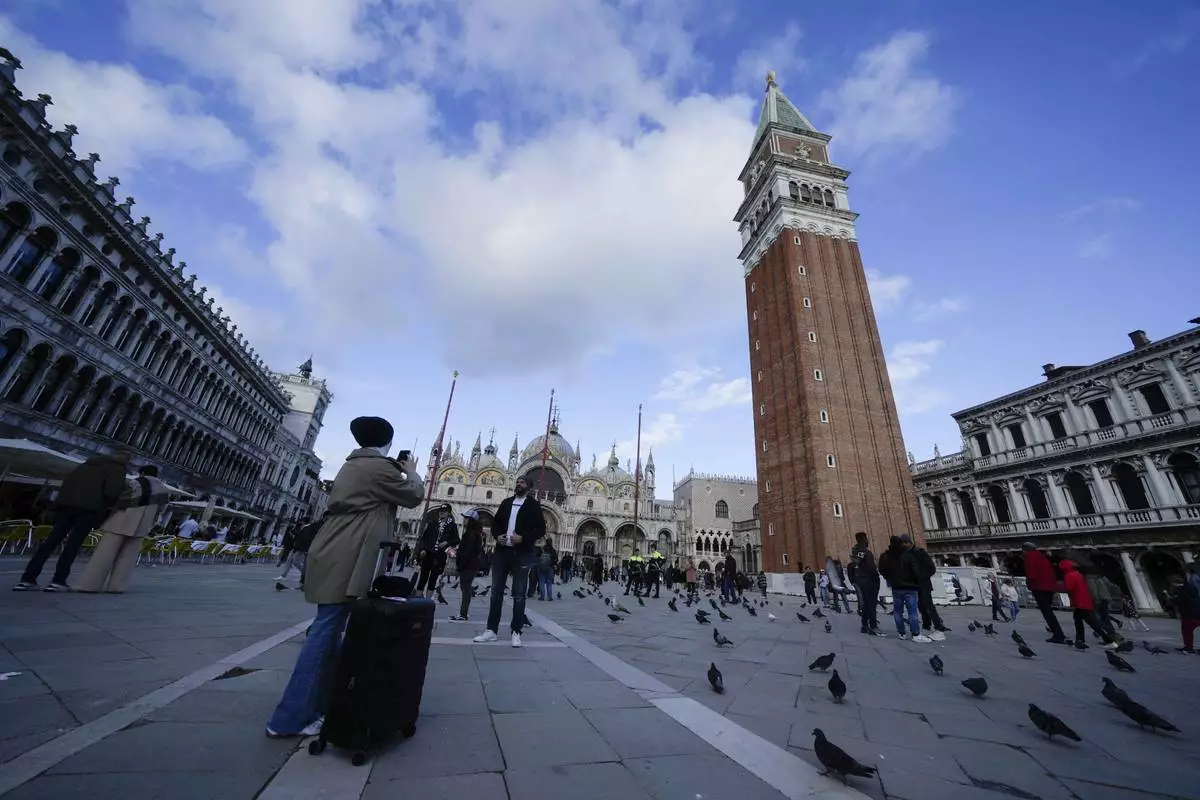
Tourists take pictures at the St. Mark square in Venice, Italy, Wednesday, April 24, 2024. The lagoon city of Venice begins a pilot program Thursday, April 25, 2024 to charge daytrippers a 5 euro entry fee that authorities hope will discourage tourists from arriving on peak days. Officials expect some 10,000 people will pay the fee to access the city on the first day, downloading a QR code to prove their payment. (AP Photo/Luca Bruno)
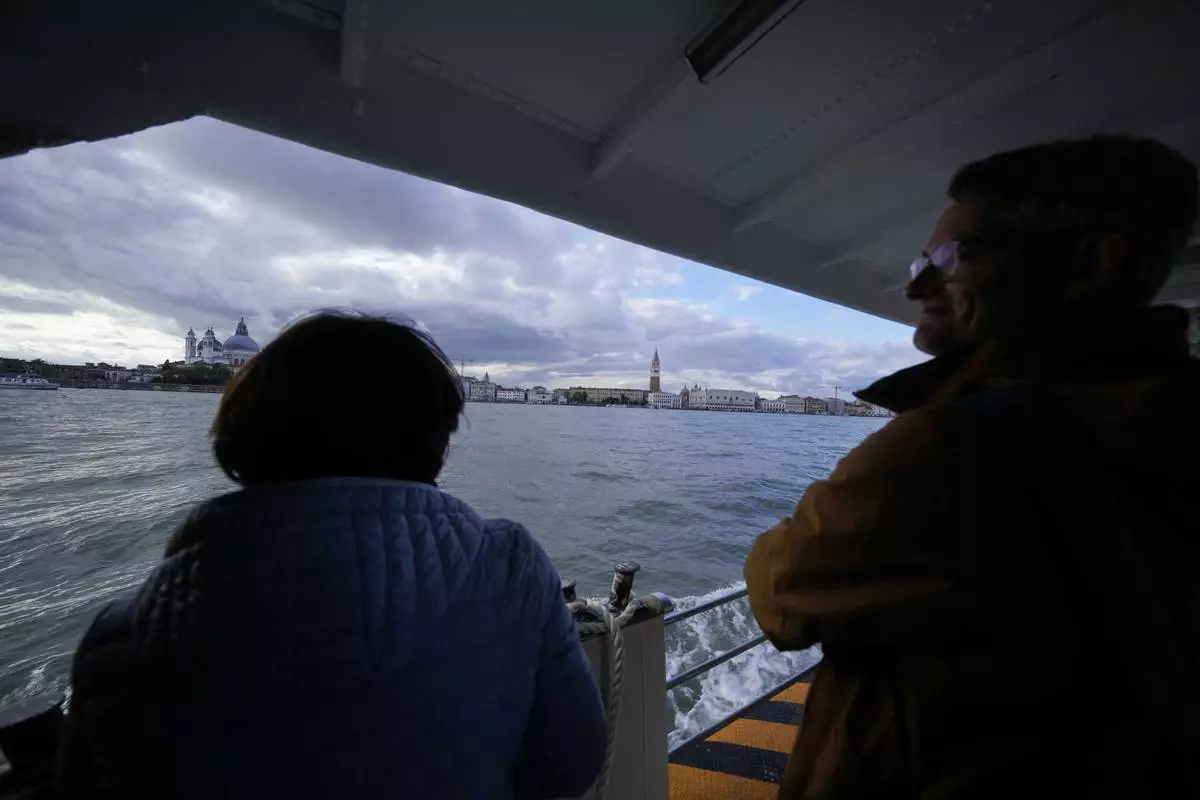
Tourists ride on a ferry boat in Venice, Italy, Wednesday, April 24, 2024. The lagoon city of Venice begins a pilot program Thursday, April 25, 2024 to charge daytrippers a 5 euro entry fee that authorities hope will discourage tourists from arriving on peak days. Officials expect some 10,000 people will pay the fee to access the city on the first day, downloading a QR code to prove their payment. (AP Photo/Luca Bruno)
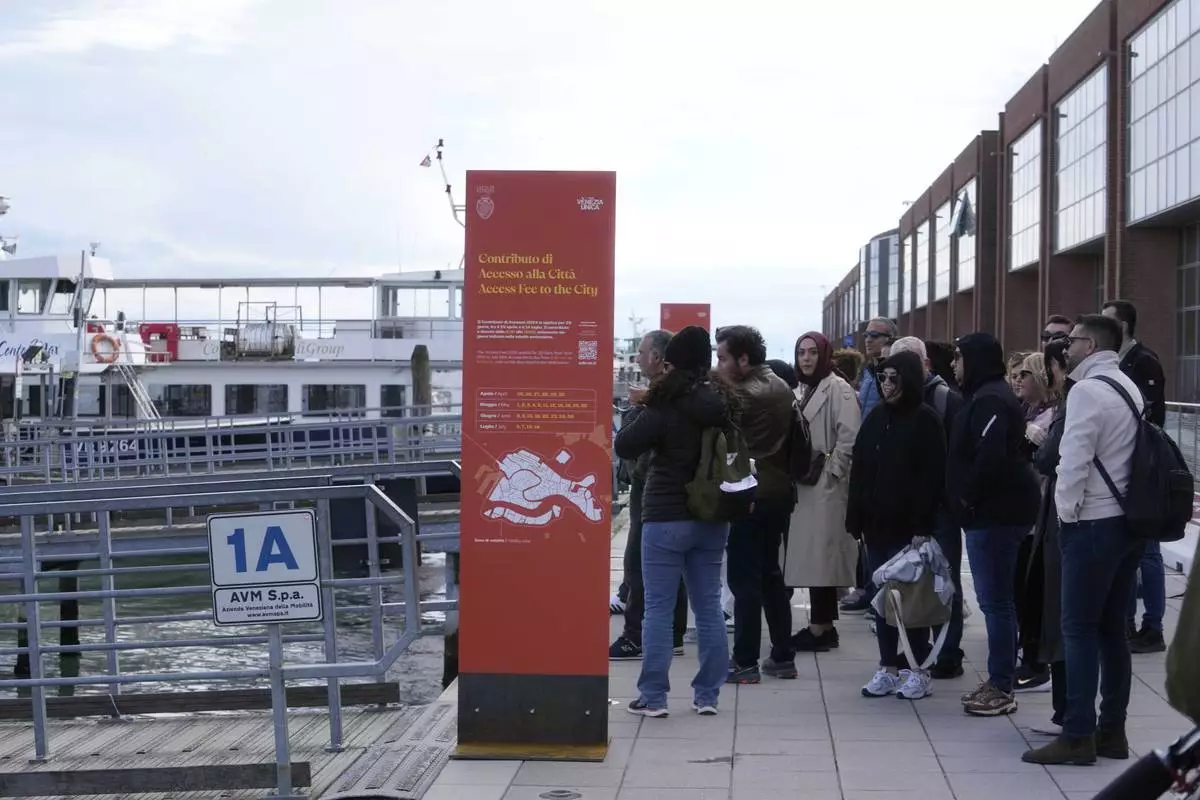
People stand in front of an information board explaining how to pay the tourist tax in Venice, Italy, Wednesday, April 24, 2024. The lagoon city of Venice begins a pilot program Thursday, April 25, 2024 to charge daytrippers a 5 euro entry fee that authorities hope will discourage tourists from arriving on peak days. Officials expect some 10,000 people will pay the fee to access the city on the first day, downloading a QR code to prove their payment. (AP Photo/Luca Bruno)
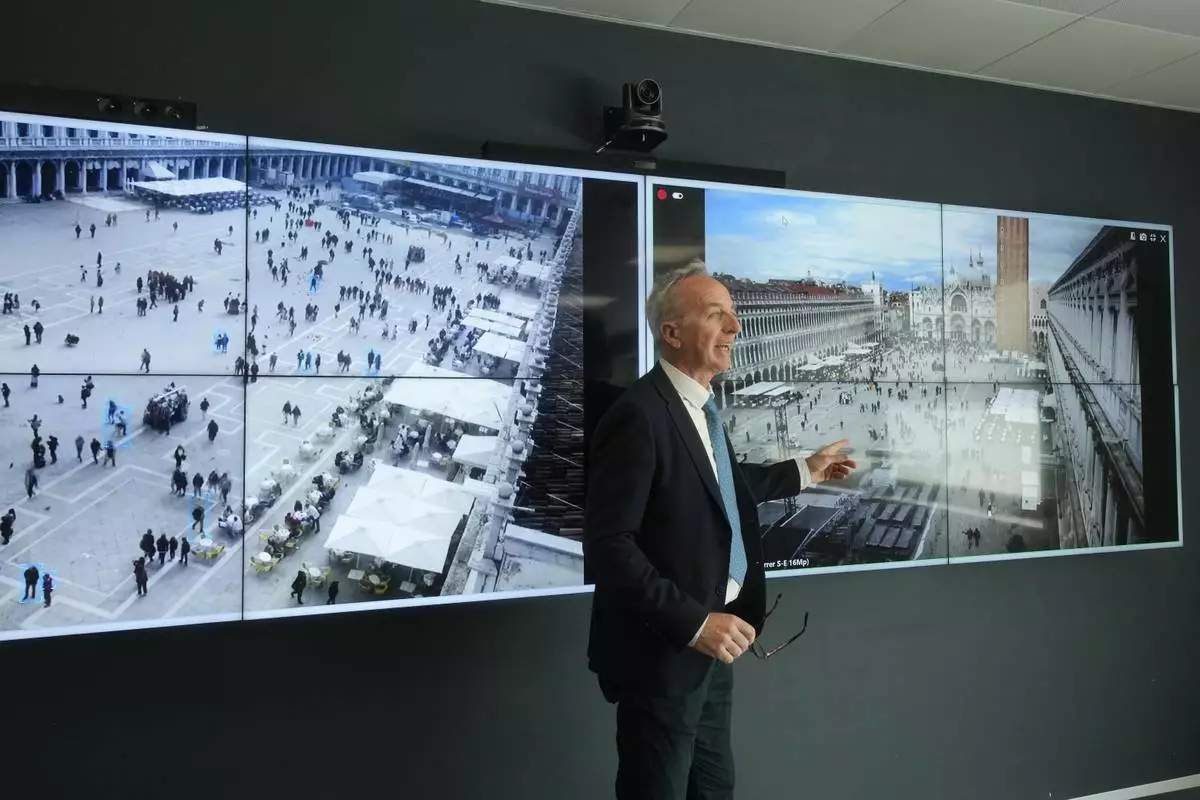
Marco Bettini, director of Venis Informatics System, gestures as he talks to reporters at the police Venice control room, in Venice, Italy, Wednesday, April 24, 2024. The lagoon city of Venice begins a pilot program Thursday, April 25, 2024 to charge daytrippers a 5 euro entry fee that authorities hope will discourage tourists from arriving on peak days. Officials expect some 10,000 people will pay the fee to access the city on the first day, downloading a QR code to prove their payment. (AP Photo/Luca Bruno)

Venice councillor Simone Venturini speaks with reporters in front of a tourist tax totem in Venice, Italy, Wednesday, April 24, 2024. The lagoon city of Venice begins a pilot program Thursday, April 25, 2024 to charge daytrippers a 5 euro entry fee that authorities hope will discourage tourists from arriving on peak days. Officials expect some 10,000 people will pay the fee to access the city on the first day, downloading a QR code to prove their payment. (AP Photo/Luca Bruno)
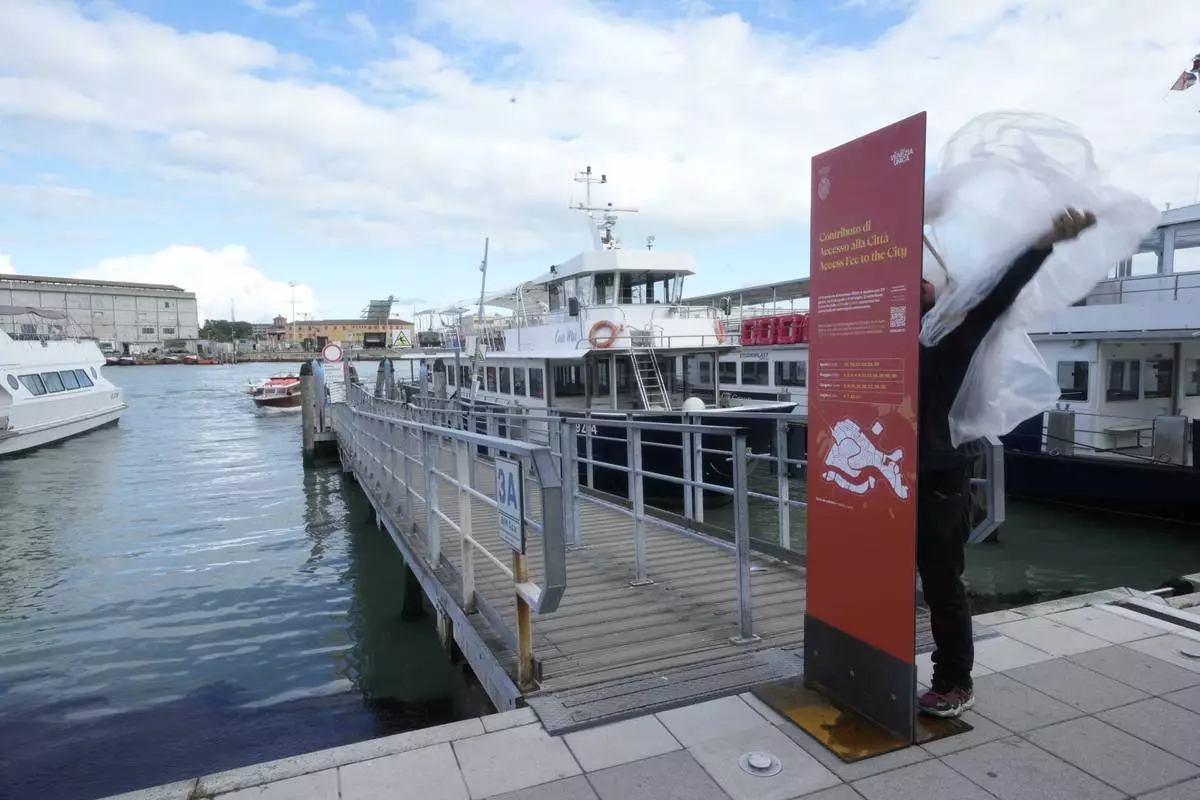
Workers prepare banner explaining how to pay the tourist tax in Venice, Italy, Wednesday, April 24, 2024. The lagoon city of Venice begins a pilot program Thursday, April 25, 2024 to charge daytrippers a 5 euro entry fee that authorities hope will discourage tourists from arriving on peak days. Officials expect some 10,000 people will pay the fee to access the city on the first day, downloading a QR code to prove their payment. (AP Photo/Luca Bruno)

Marco Bettini, director of Venis Informatics System, gestures as he explains the Venice density to reporters at the police Venice control room in Venice, Italy, Wednesday, April 24, 2024. The lagoon city of Venice begins a pilot program Thursday, April 25, 2024 to charge daytrippers a 5 euro entry fee that authorities hope will discourage tourists from arriving on peak days. Officials expect some 10,000 people will pay the fee to access the city on the first day, downloading a QR code to prove their payment. (AP Photo/Luca Bruno)
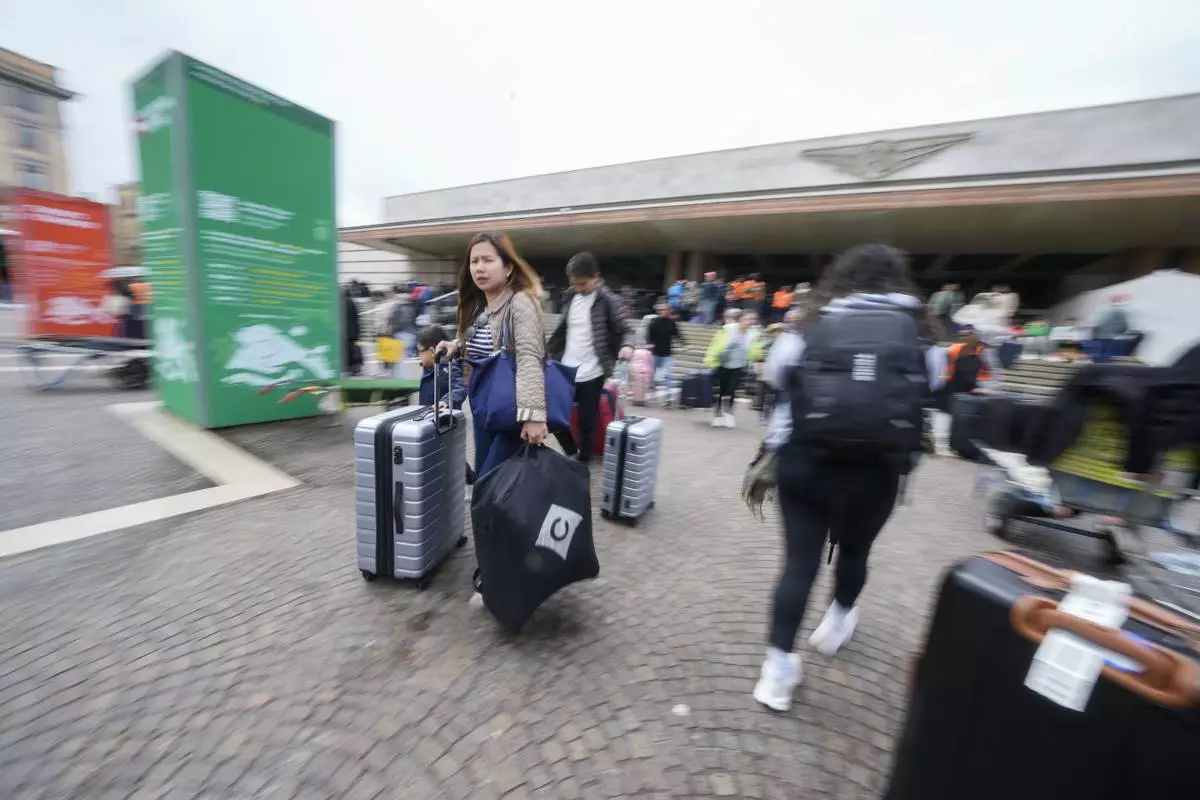
Tourists arrive at the main train station in Venice, Italy, Wednesday, April 24, 2024. The lagoon city of Venice begins a pilot program Thursday, April 25, 2024 to charge daytrippers a 5 euro entry fee that authorities hope will discourage tourists from arriving on peak days. Officials expect some 10,000 people will pay the fee to access the city on the first day, downloading a QR code to prove their payment. (AP Photo/Luca Bruno)
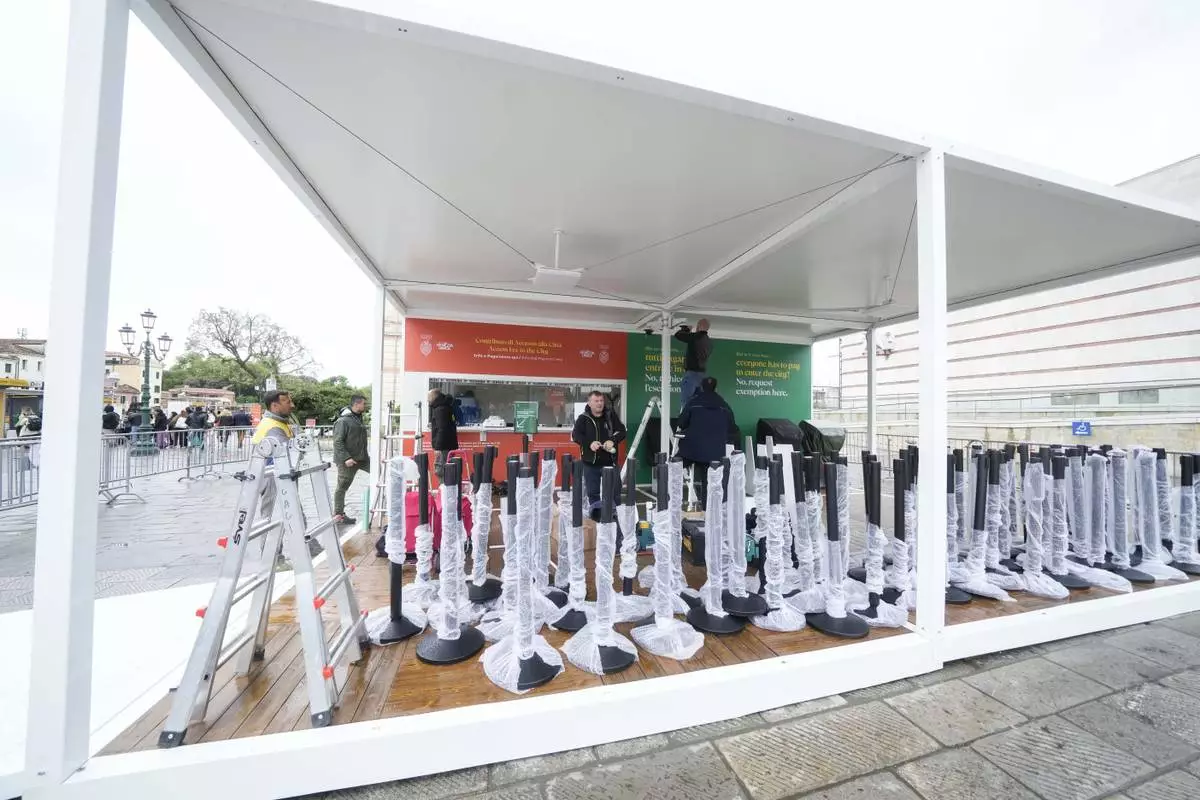
Workers prepare the tourist tax cashier desks outside the main train station in Venice, Italy, Wednesday, April 24, 2024. The lagoon city of Venice begins a pilot program Thursday, April 25, 2024 to charge daytrippers a 5 euro entry fee that authorities hope will discourage tourists from arriving on peak days. Officials expect some 10,000 people will pay the fee to access the city on the first day, downloading a QR code to prove their payment. (AP Photo/Luca Bruno)
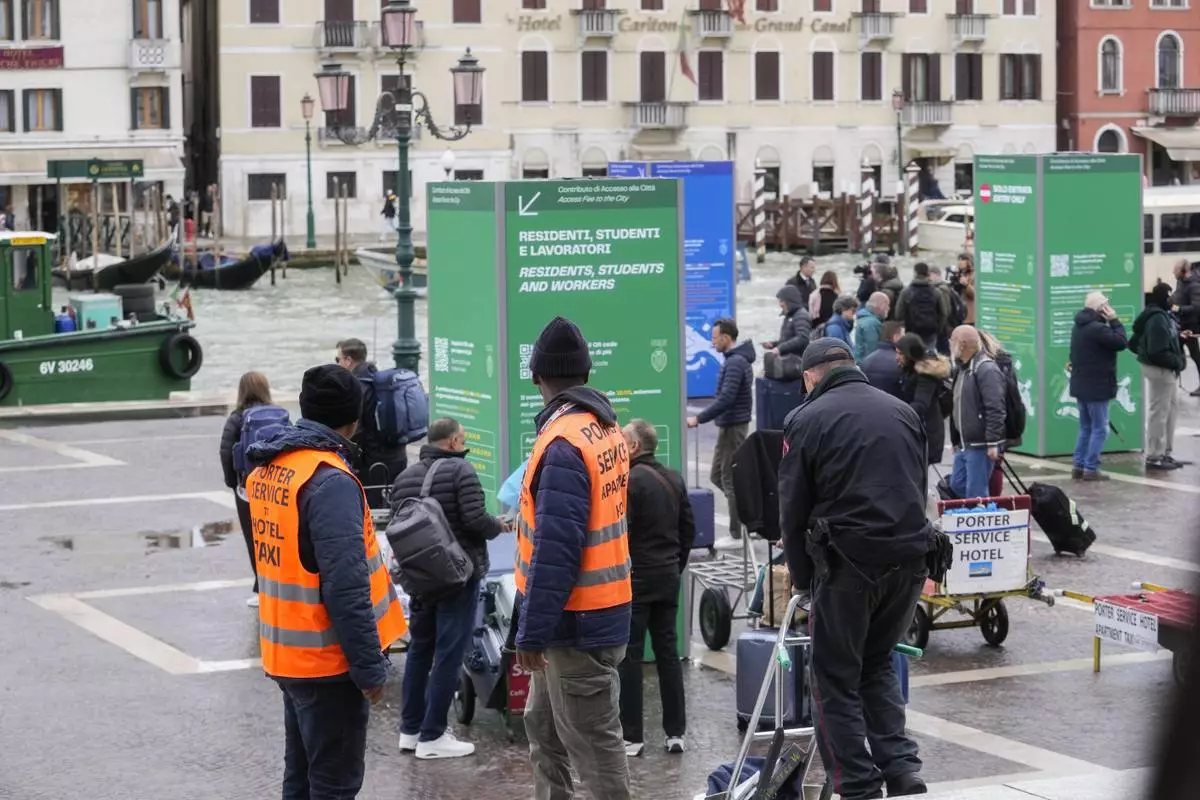
Porters wait for tourists outside the main train station in Venice, Italy, Wednesday, April 24, 2024. The lagoon city of Venice begins a pilot program Thursday, April 25, 2024 to charge daytrippers a 5 euro entry fee that authorities hope will discourage tourists from arriving on peak days. Officials expect some 10,000 people will pay the fee to access the city on the first day, downloading a QR code to prove their payment. (AP Photo/Luca Bruno)
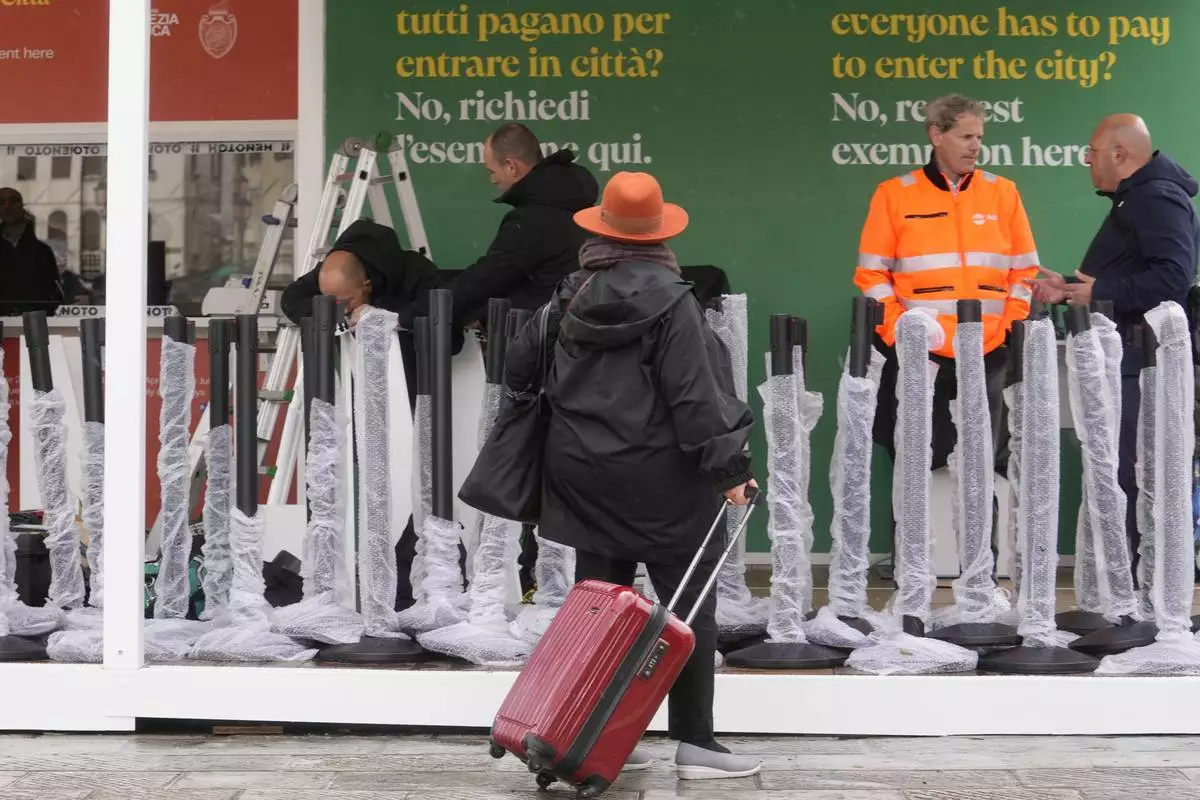
Workers prepare the tourist tax cashier desks outside the main train station in Venice, Italy, Wednesday, April 24, 2024. The lagoon city of Venice begins a pilot program Thursday, April 25, 2024 to charge daytrippers a 5 euro entry fee that authorities hope will discourage tourists from arriving on peak days. Officials expect some 10,000 people will pay the fee to access the city on the first day, downloading a QR code to prove their payment. (AP Photo/Luca Bruno)
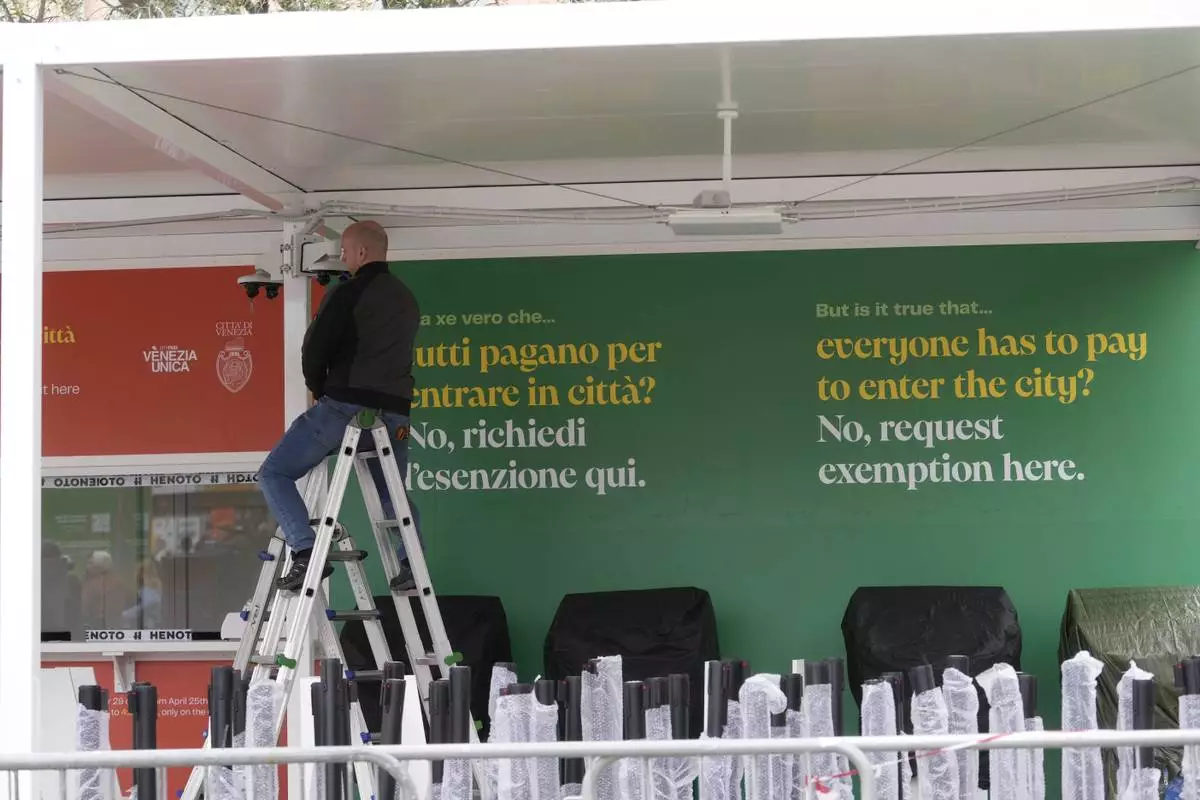
Workers prepare the tourist tax cashier desks outside the main train station in Venice, Italy, Wednesday, April 24, 2024. The lagoon city of Venice begins a pilot program Thursday, April 25, 2024 to charge daytrippers a 5 euro entry fee that authorities hope will discourage tourists from arriving on peak days. Officials expect some 10,000 people will pay the fee to access the city on the first day, downloading a QR code to prove their payment. (AP Photo/Luca Bruno)

Porters wait for tourists outside the main train station in Venice, Italy, Wednesday, April 24, 2024. The lagoon city of Venice begins a pilot program Thursday, April 25, 2024 to charge daytrippers a 5 euro entry fee that authorities hope will discourage tourists from arriving on peak days. Officials expect some 10,000 people will pay the fee to access the city on the first day, downloading a QR code to prove their payment. (AP Photo/Luca Bruno)
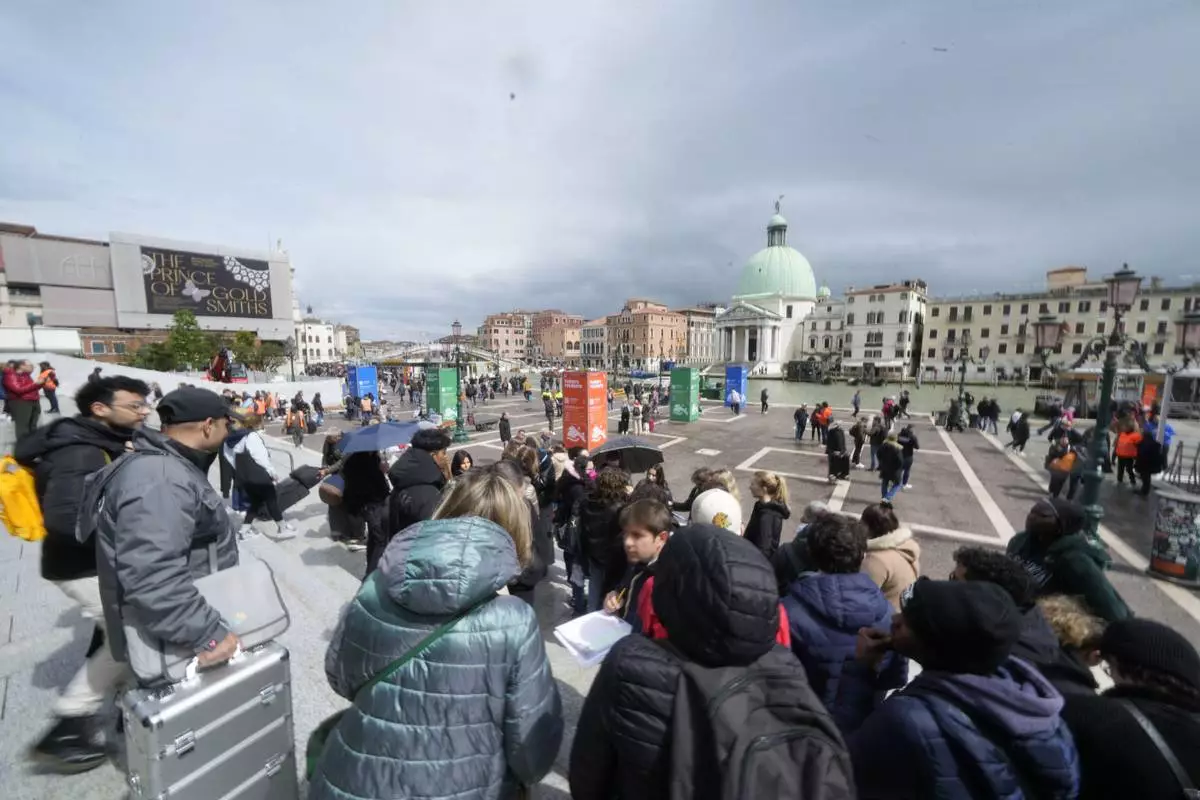
Tourists arrive outside the main train station in Venice, Italy, Wednesday, April 24, 2024. The lagoon city of Venice begins a pilot program Thursday, April 25, 2024 to charge daytrippers a 5 euro entry fee that authorities hope will discourage tourists from arriving on peak days. Officials expect some 10,000 people will pay the fee to access the city on the first day, downloading a QR code to prove their payment. (AP Photo/Luca Bruno)
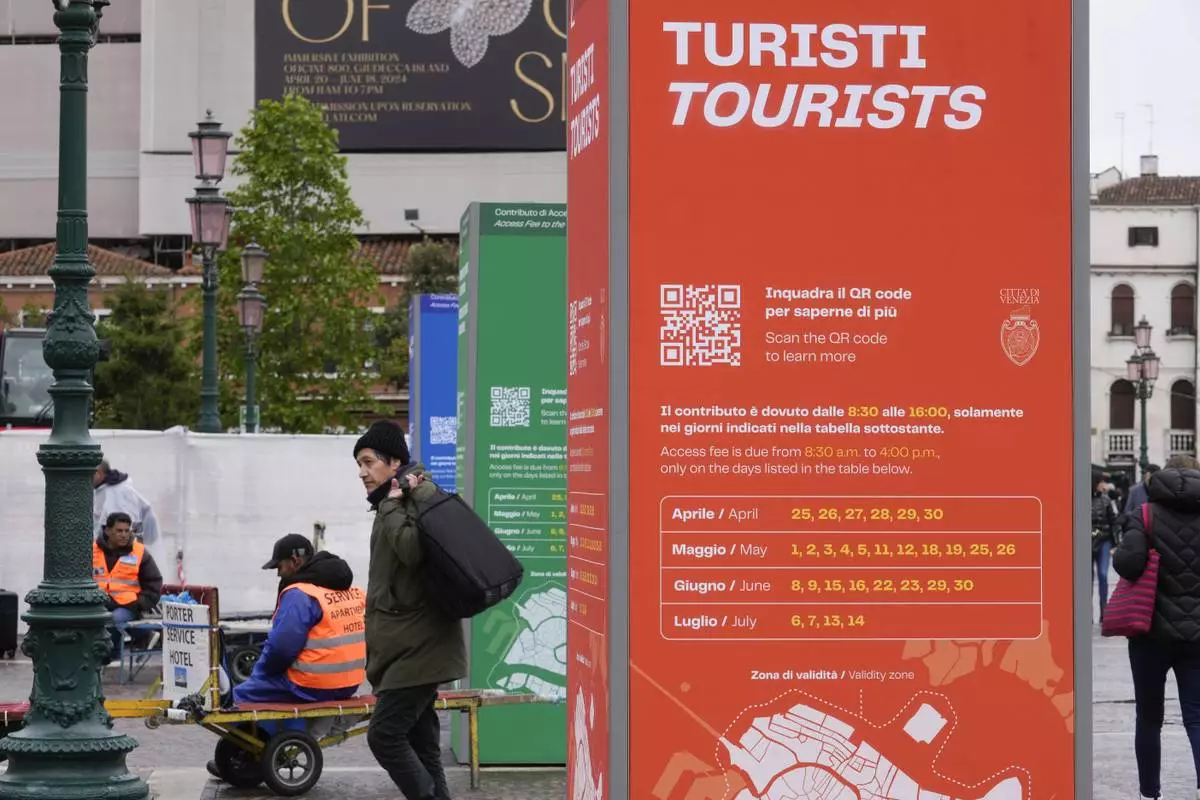
Tourist information boards are seen outside the main train station in Venice, Italy, Wednesday, April 24, 2024. The lagoon city of Venice begins a pilot program Thursday, April 25, 2024 to charge daytrippers a 5 euro entry fee that authorities hope will discourage tourists from arriving on peak days. Officials expect some 10,000 people will pay the fee to access the city on the first day, downloading a QR code to prove their payment. (AP Photo/Luca Bruno)
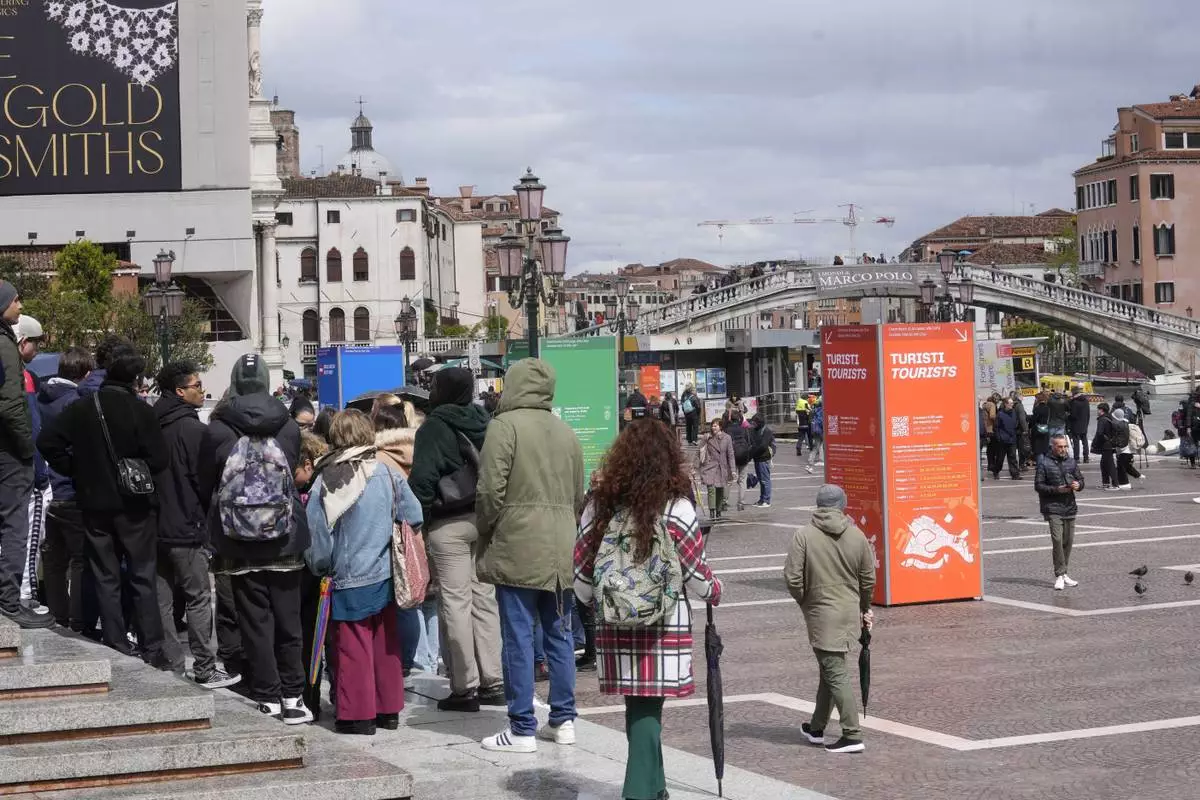
Tourists arrive outside the main train station in Venice, Italy, Wednesday, April 24, 2024. The lagoon city of Venice begins a pilot program Thursday, April 25, 2024 to charge daytrippers a 5 euro entry fee that authorities hope will discourage tourists from arriving on peak days. Officials expect some 10,000 people will pay the fee to access the city on the first day, downloading a QR code to prove their payment. (AP Photo/Luca Bruno)































